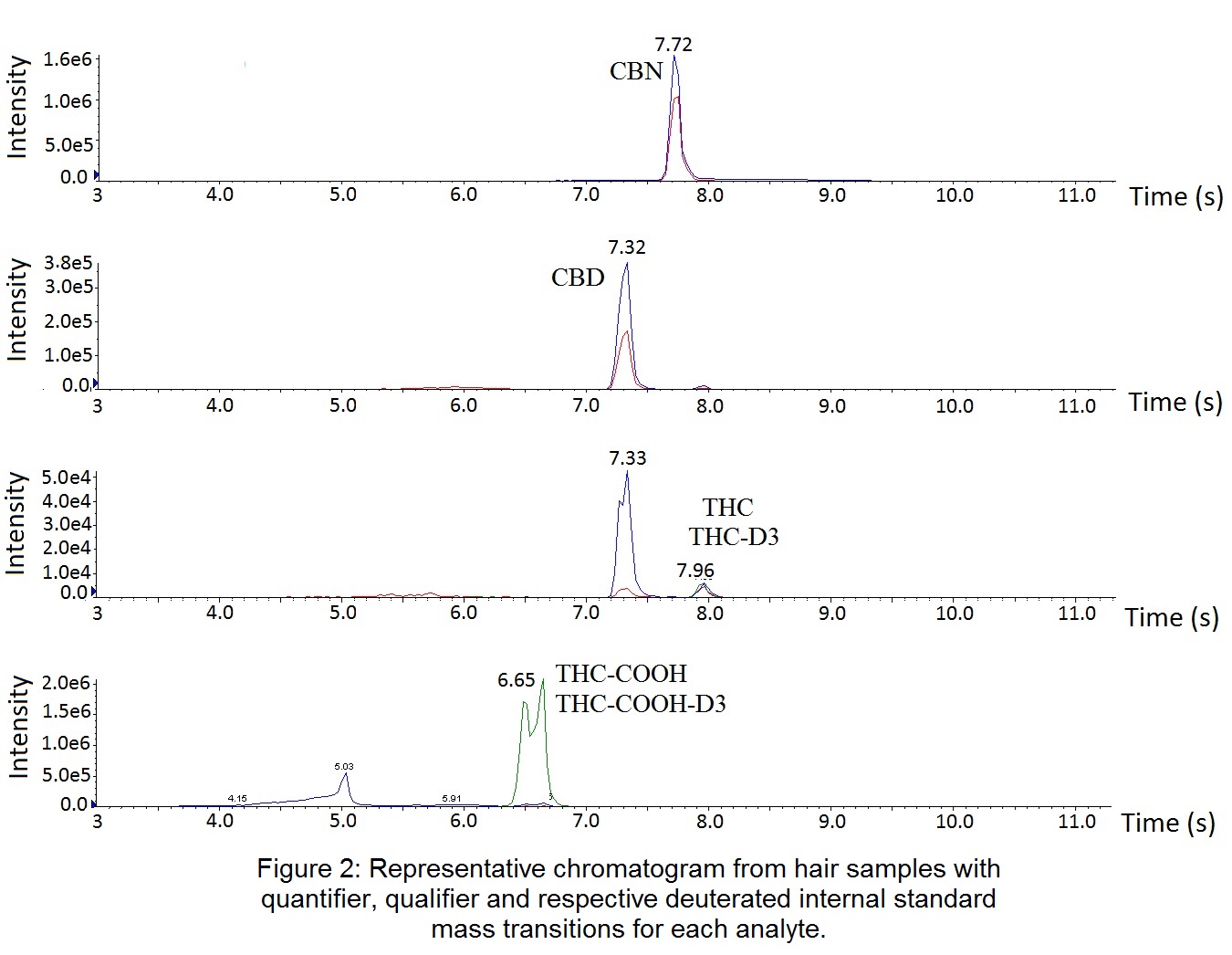|
Introduction
Cannabis is the most widely used drug in France. It is extracted from Cannabis sativa plant that contains several natural compounds called cannabinoids. In forensic cases or monitoring of drug addiction, the biochemistry laboratory of the Regional Hospital Center of Orleans has already developed an assay to detect and quantify these substances in blood. Cannabinoids are detectable until 24 to 48 hours in blood and up to 4 days in urine. Their detection in hairdepends only on their length. A dosage in this matrix is potentially required in contexts of driving license restitution or drug facilitated crimes. The biochemistry lab decided to perform the cannabinoids dosage in hair by high performance liquid chromatography coupled to tandem mass spectrometry (LC-MS/MS). The method includes the simultaneous dosage of tetrahydrocannabinol (THC), cannabidiol (CBD), cannabinol (CBN) and carboxytétrahydrocannabinol(THCCOOH) a metabolite derived from the oxidation of THC in humans.
Experimental conditions
Standard solutions (THC, THC-COOH, CBD and CBN) and respective deuterated internal standards (THC-D3 and THC-COOH-D3) were purchased from LGC Standards (Molsheim, France). Internal standards have respectively the same physicochemical properties that THC and THC-COOH and thus correct errors during the manipulation. Analyses were performed on a liquid chromatographic system made of two LC-20ADxr pumps, a SIL20AC autosampler and a CTO20AC oven (Shimadzu, Marne la Vallée, France) coupled to a 5500 QTRAP mass spectrometer (Sciex, Les Ulis, France). The development of this method was divided into 3 steps:
1) the characteristic transitions (m/z) of molecules were determined after ionization tests and detection tests in multiple reaction monitoring (MRM) mode.
2) the analytical parameters were optimized by testing different columns and composition of mobile phases to reduce analysis time with an optimal retention time of molecules.
3) after a literature review, hair decontamination and analytes extraction procedure from the matrix were experimented.
Results
Analytes were revealed after electrospray ionization followed by MRM analysis in negative mode. The positive mode gave the same transitions (m/z) for the THC and the CBD, so it could not be differentiated (Figure 1). In negative mode, transitions of THC and CBD were closed. Therefore, an analytical separation of these compounds was necessary. Separation of THC and CBD was obtained on Kinetex C18 column (50 mm × 3 mm i.d., 2,6 µm) (Phenomenex, Le Pecq, France) with a good sensitivity. Composition of the mobile phase was determined after drawing a compound retention curve. The mobile phase was a gradient mixture of water with 0.1 % of formic acid (A) and acetonitrile with 0.1 % of formic acid (B). The gradient was programmed as follows: 0-1.5 min, 20% B; 1.5-7 min, 20 to 95% B; 7 to 8 min decrease to 20% B to return to initial conditions; column re-equilibration with 20% B during 2.5 min. Different organic solvents and mixture of solvents were tested to find optimal extracting agent for all analytes. In addition, the influence of extraction time was evaluated. Finally, after a decontamination of hair with successive water and dichloromethane baths, samples were extracted in methanol for 4h at room temperature. A typical chromatogram of a hair sample is shown in Figure 2.
Conclusion
Cannabinoids dosage development will be continued with a validation of the method in accordance with criteria of ISO 15189.
|
|

Fragmentation of THC and CBD in positive and negative ion mode

Representative chromatogram from hair samples with quantifier, qualifier and respective deuterated internal standard mass transitions for each analyte.
|



